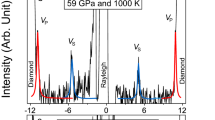Abstract
Silicon oxycarbide glass is formed by the pyrolysis of silicone resins and contains only silicon, oxygen, and carbon. The glass remains amorphous in x-ray diffraction to 1400 °C and shows no features in transmission electron micrographs (TEM) after heating to this temperature. After heating at higher temperature (1500–1650 °C) silicon carbide lines develop in x-ray diffraction, and fine crystalline regions of silicon carbide and graphite are found in TEM and electron diffraction. XPS shows that silicon-oxygen bonds in the glass are similar to those in amorphous and crystalline silicates; some silicons are bonded to both oxygen and carbon. Carbon is bonded to either silicon or carbon; there are no carbon-oxygen bonds in the glass. Infrared spectra are consistent with these conclusions and show silicon-oxygen and silicon-carbon vibrations, but none from carbon-oxygen bonds. 29Si-NMR shows evidence for four different bonding groups around silicon. The silicon oxycarbide structure deduced from these results is a random network of silicon-oxygen tetrahedra, with some silicons bonded to one or two carbons substituted for oxygen; these carbons are in turn tetrahedrally bonded to other silicon atoms. There are very small regions of carbon-carbon bonds only, which are not bonded in the network. This “free” carbon colors the glass black. When the glass is heated above 1400 °C this network composite rearranges in tiny regions to graphite and silicon carbide crystals. The density, coefficient of thermal expansion, hardness, elastic modulus, index of refraction, and viscosity of the silicon oxycarbide glasses are all somewhat higher than these properties in vitreous silica, probably because the silicon-carbide bonds in the network of the oxycarbide lead to a tighter, more closely packed structure. The oxycarbide glass is highly stable to temperatures up to 1600 °C and higher, because oxygen and water diffuse slowly in it.
Similar content being viewed by others
References
G. M. Renlund, S. Prochazka, and R. H. Doremus, J. Mater. Res. 6, 2716 (1991).
G. M. Renlund, “Silicon Oxycarbide Glasses”, Ph.D. Thesis, Rensselaer Polytechnic Institute, Troy, NY, 1989.
C. F. Smith and W. B. Crandall, “Method of Making Carbon Containing Glasses”, U.S. Patent No. 3 378431 (1968).
T. H. Elmer and H. E. Meissner, J. Am. Ceram. Soc. 59, 206 (1976).
S. Yajima, Y. Hasegawa, J. Hayashi, and M. Iimura, J. Mater. Sci. 13, 2569 (1978).
R. F. Cooper and K. Chyung, J. Mater. Sci. 22, 3148 (1987).
F. Babonneau, K. Thorne, and J. D. Mackenzie, Chem. of Mater. 1, 554 (1989).
H. Zhang and C. G. Pantano, J. Am. Ceram. Soc. 73, 958 (1990).
J. Homeny and G. G. Nelson, ibid. 71, 386 (1988).
R. E. Loehman, in Treatise on Materials Science and Technology, edited by M. Tomozawa and R. H. Doremus (Academic Press, San Diego, CA, 1985), Vol. 26, p. 119.
S. Saaka, Annu. Rev. Mater. Sci. 16, 29 (1986).
B. E. Warren, X-Ray Diffraction (Addison-Wesley, Reading, MA, 1969), p. 253 (Dover, 1990).
C. S. Vonk, J. Appl. Cryst. 9, 433 (1976).
Handbook of X-Ray Photoelectron Spectroscopy, edited by C. D. Wagner, W. M. Riggs, L. E. Davis, J. F. Moulder, and G. E. Muilenberg (Perkin-Elmer Co., Eden Prairie, MN, 1979).
J. Simon, in Modern Aspects of the Vitreous State, edited by J. D. Mackenzie (Butterworth’s, London, 1960), Vol. I, p. 138.
G. H. Sigel, in Treatise on Materials Science and Technology, edited by M. Tomozawa and R. H. Doremus (Academic Press, San Diego, CA, 1975), Vol. 12, p. 1.
R. A. Sheperd and W. R. M. Graham, “Study of the Spectra and Structure of the SiC2 Radical at 8 °K,” NBS Special Pub., 716, 604–613 (1986).
F. Tunistra and J. L. Roenig, J. Chem. Phys. 53, 1126–1130 (1970).
M. J. Nathan, J. E. Sith, and K. N. Tu, J. Appl. Phys. 45, 2370 (1974).
N. P. Bansal and R. H. Doremus, Handbook of Glass Properties (Academic Press, San Diego, CA, 1986), Chap. 2.
G. Urbain, Rev. Int. Htes. Temp, et Refr. 11, 133–145 (1974).
F. E. Wagstaff, J. Am. Ceram. Soc. 52, 650 (1969).
R. B. Sosman, The Properties of Silica (Chemical Catalog Co., New York, 1927), pp. 41–59.
NMR Basic Principles and Progress, edited by P. Diel, E. Fluck, and R. Kosfeld (Springer-Verlag, Frankfurt, 1981).
Author information
Authors and Affiliations
Rights and permissions
About this article
Cite this article
Renlund, G.M., Prochazka, S. & Doremus, R.H. Silicon oxycarbide glasses: Part II. Structure and properties. Journal of Materials Research 6, 2723–2734 (1991). https://doi.org/10.1557/JMR.1991.2723
Received:
Accepted:
Published:
Issue Date:
DOI: https://doi.org/10.1557/JMR.1991.2723




